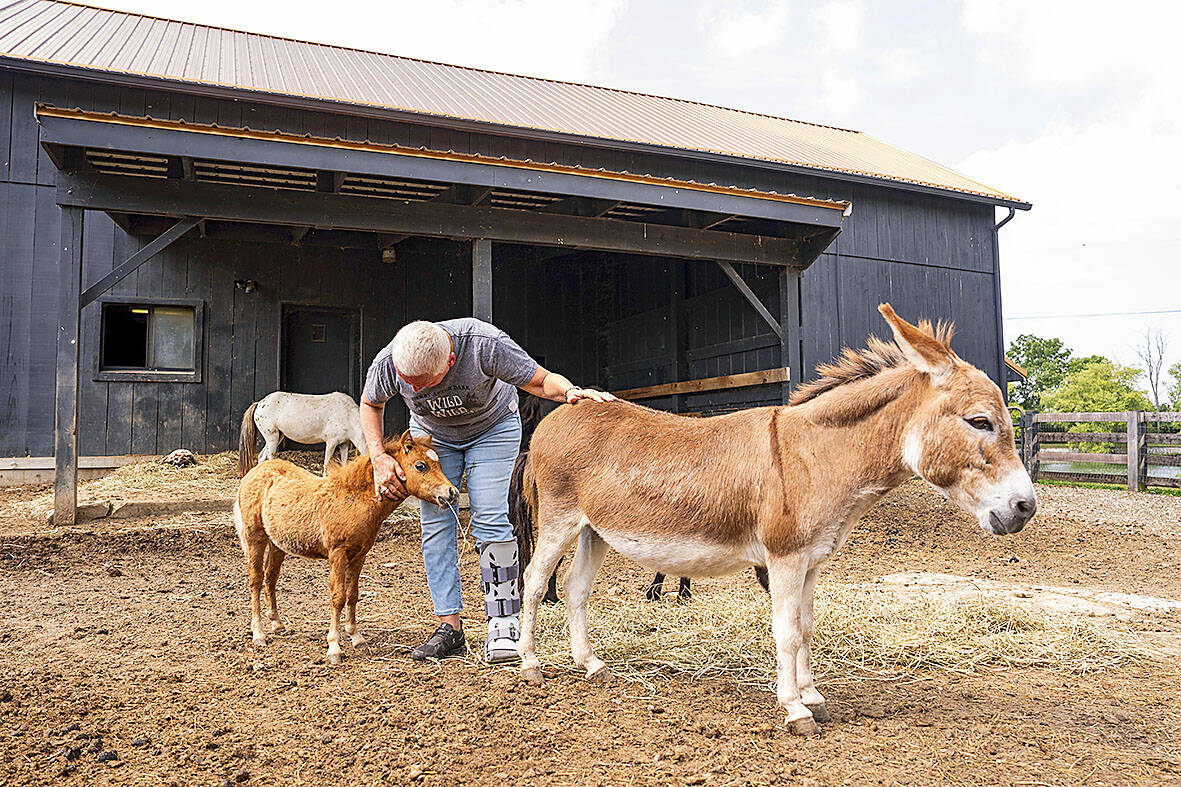They’re adorable. They require less food and space. And without much coaxing, they might help cut the grass.
Americans are showing more interest in owning miniature cows, goats, donkeys and other diminutive farm animals, a trend driven by hobby farmers looking for easy-to-manage livestock and homesteaders who like the idea of having a petite pig or a scaled-down sheep as a pet.
Animal breeders say sales of pint-sized farm animals have grown since the COVID-19 pandemic, when more people started raising backyard chickens for fun and fresh eggs. Like chickens, mini farm animals appeal to beginners who want the taste of a rugged, agrarian lifestyle.

Photo: AP
“A lot of people don’t have access to several acres, but if they have a one-acre plot, they can keep a miniature cow or a few miniature goats,” said Brian Gazda, who has a small farm in East Idaho and with two friends runs a YouTube channel called “Hobby Farm Guys.”
Platforms like YouTube and especially TikTok have played an important part in raising the profile of mini farm animals, said Martin Fysh, a vice president and divisional merchandising manager for rural lifestyle retailer Tractor Supply Co. On any given day, TikTok users put cuteness on parade with videos of tiny blue-eyed goats and 2-foot-tall horses that have received millions of views.
But Fysh thinks the trend also reflects a natural progression among customers who started out with a backyard hen coop. In response, Tractor Supply has increased its selection of treats for both mini and regular sized pigs, and goats.
“They’re seen as part of the extended family,” Fysh said.
While some people buy small farm animals as a stepping stone to owning larger ones, others don’t have a desire to expand. Some owners of mini farm animals turn their hobbies into side hustles by giving visitor tours, breeding animals, and blogging about their pastoral experiences.
But before playing Old Macdonald, newcomers need to weigh the pros and cons, Gazda and other hobby farmers said.
Among the challenges: the volatile nature of prices for each of the types of miniature farm animals. And while they’re cute, they can also be aggressive.
MINI GOATS
Brittany Snow, a high school English teacher in Florida, owns several small-sized Nigerian Dwarf goats. She realized her dream of living on a farm three years ago when her family moved from the Jacksonville suburb of Middleburg to nearby Melrose.
She said her family wanted to be more self-sustaining after the pandemic and now sources its own dairy products, such as milk and eggs. She sticks mostly with miniature animals because they’re easier to take care of and cost less to acquire and feed.
Snow, 32, started with four Nigerian Dwarf goats: Buttercup, Snowflake, Cash and Peanut. The herd has since expanded to include Pancake and Oreo, the kids of Peanut and Buttercup.
Snow purchased the Nigerian Dwarf goats intending to milk them to make cheese and products like soap and lotion. But that hasn’t worked yet because goats only lactate after giving birth, and Buttercup only recently had her kids.
“The past few years have been a learning curve,” Snow said.
Mini goats are one of the most popular entry-level mini animals. In the past year, animal breeders have registered roughly 8,330 mini goats with the Miniature Dairy Goat Association. That’s a 73 percent jump from the 12 months before July 2021, when registrations — mostly for newborn females sought after by breeders — totaled just under 4,800, said Angelia Alden, a business operations manager for the North Carolina-based organization.
Many folks who favor mini goats, however, tend to sell them after a few years because it can be challenging — and expensive — to take care of them, Alden said. Rising animal feed costs can be a headache, as is finding adequate medical care due to a shortage of farm veterinarians.
MINI COWS AND DONKEYS
A farm animal can be both mini and mighty. Some of the four-legged stars on social media are furry cows that can weigh 500-600 pounds. The smallest, which stand under 3 feet in height, are known as micro-miniatures. The slightly bigger miniatures can be as tall as 42 inches, according to Allie Sine, a TikTok creator with more than 737,000 followers on the platform. Videos showcasing some of her mini cows have gotten millions of views.
Sine, 28, launched her own business breeding and selling mini cows in 2020 after reselling a sick mini cow that cost US$350 for US$5,000. Last year, she sold about 190 calves through her Missouri-based business, Mini Moos LLC. The calves were roughly split between mini and micromini cows that can cost from US$2,000 to US$30,000.
“Everything just skyrocketed,” Sine said.
Others report a similar boom.
Kim Furches, who owns a farm with her husband, Ken, in West Jefferson, North Carolina, said the couple bred mini donkeys for about 20 years and currently own dozens of Mediterranean miniature donkeys, which stand 3 feet high or less.
Before the pandemic, they would typically sell about eight donkeys per year and count themselves lucky if they received a couple thousand dollars for one. They now sell about 20 per year. The last mini donkey sold for US$7,500, Furches said. There are some she’s only willing to sell for US$9,000 or more.
NEW TYPE OF EXOTIC PET
Though some of their customers plan to breed and sell mini animals, too, many say many are just looking for “exotic” pets, Gazda said.
Earlier this year, Jamie Campion, 41, and her husband, Jeff, bought two Southdown Babydoll sheep from a local breeder near their home in Thompson’s Station, Tennessee, for US$800 each. The couple moved from Chicago in March 2022 after the pandemic made them rethink their lifestyle. They now live in a modern-style farmhouse built on an acre of land.
While Biscuit and Buttermilk have become excellent lawn trimmers, Jamie Campion said she considers the animals — which weigh about 70 pounds and stand 20 inches high — similar to a dog or a cat.
“They eat the grass, so we don’t even have to buy food (for the sheep) on a weekly basis,” said Campion who discovered the breed on Instagram.
But it can be challenging.
One time, Jeff Campion tried to inject one of sheep with oral medication to treat parasites, and it tore his bicep.
But more often, the sheep give her joy. Jamie Campion recalls taking them out on a snowy day for a walk in the neighborhood, without a leash.
“They just followed right behind,” she said. “There’s a whole sheep and shepherd relationship. “
THERAPY
Others see therapeutic benefits.
Lisa Moad, who is the owner of Seven Oaks Farm in Hamilton, Ohio and has 13 miniature horses and three regular size horses, operates a therapy farm for older people and others. She also used to take the miniature horses to local nursing homes and hospitals. But since the pandemic, she has spent most of her timing conducting online training for those looking to embrace the same mission.
That includes teaching horses how to maneuver around wheelchairs and into elevators of hospitals. She said her miniature versions still weigh 175 to 200 pounds, though much less than her regular horses, which range from 1,200 to 1,500 pounds.
“They’re docile, but they can get frightened easily, ” she said. “You just can’t walk into a hospital with a horse.”

June 9 to June 15 A photo of two men riding trendy high-wheel Penny-Farthing bicycles past a Qing Dynasty gate aptly captures the essence of Taipei in 1897 — a newly colonized city on the cusp of great change. The Japanese began making significant modifications to the cityscape in 1899, tearing down Qing-era structures, widening boulevards and installing Western-style infrastructure and buildings. The photographer, Minosuke Imamura, only spent a year in Taiwan as a cartographer for the governor-general’s office, but he left behind a treasure trove of 130 images showing life at the onset of Japanese rule, spanning July 1897 to

One of the most important gripes that Taiwanese have about the Democratic Progressive Party (DPP) is that it has failed to deliver concretely on higher wages, housing prices and other bread-and-butter issues. The parallel complaint is that the DPP cares only about glamor issues, such as removing markers of Chinese Nationalist Party (KMT) colonialism by renaming them, or what the KMT codes as “de-Sinification.” Once again, as a critical election looms, the DPP is presenting evidence for that charge. The KMT was quick to jump on the recent proposal of the Ministry of the Interior (MOI) to rename roads that symbolize

On the evening of June 1, Control Yuan Secretary-General Lee Chun-yi (李俊俋) apologized and resigned in disgrace. His crime was instructing his driver to use a Control Yuan vehicle to transport his dog to a pet grooming salon. The Control Yuan is the government branch that investigates, audits and impeaches government officials for, among other things, misuse of government funds, so his misuse of a government vehicle was highly inappropriate. If this story were told to anyone living in the golden era of swaggering gangsters, flashy nouveau riche businessmen, and corrupt “black gold” politics of the 1980s and 1990s, they would have laughed.

In an interview posted online by United Daily News (UDN) on May 26, current Chinese Nationalist Party (KMT) Chairman Eric Chu (朱立倫) was asked about Taichung Mayor Lu Shiow-yen (盧秀燕) replacing him as party chair. Though not yet officially running, by the customs of Taiwan politics, Lu has been signalling she is both running for party chair and to be the party’s 2028 presidential candidate. She told an international media outlet that she was considering a run. She also gave a speech in Keelung on national priorities and foreign affairs. For details, see the May 23 edition of this column,